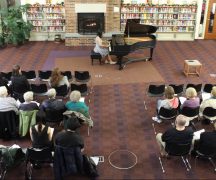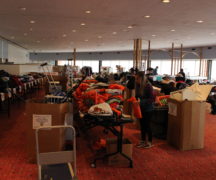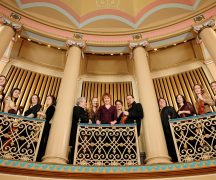By DAVID DUPONT
BG Independent News
As the fall semester enters that time when it is inarguably fall, and the cold weather settles in, arts activities on campus pick up steam.
Perdito Martinez Group at Kobacker

Speaking of bringing the heat, that’s exactly what the Pedrito Martinez Group did on Thursday night. Walking into Kobacker Hall it was evident something was afoot. More people were clustered toward the front of the house, and the floor of the orchestra pit had been raised so it was level with the first row of seats — space for dancing.
In his introduction to the concert Dean William Mathis said he’d heard there were people ready to move.
The quartet led by Cuban-born percussion master Martinez delivered a tidal wave of rhythm that swept up the crowd. Martinez delivered the lead vocals with a melodic shout and his three bandmates answered him.
First, one woman left her seat with another on her heels. A young man strode down the aisles toward the stage, and then people, mostly students, streamed down the arms of the mezzanine. Soon the area in front of the stage was packed with a 100 or so dancers, and they didn’t leave for the rest of the two-hour long program, much to the delight of the musicians.
The group mixes the raw energy of folk music with tight arrangements. The torrent of rhythm would be punctuated by sudden stops, after a instant the cascade music would resume.
Sitting in the center of the house were the couple, Dorothy and DuWayne Hansen, who created the Hansen Musical Arts Series that since 2003 has brought artists and scholars to campus to perform, speak, and interact with students.
After the free concert Dorothy Hansen said they didn’t envision anything like the party sparked by Martinez and company when they founded the series. Kobacker Hall had a different atmosphere.
“The Telephone”

This time of year first year masters in performance students start popping up in venues around the community. As part of a professional practices class taught by Andrew Pelletier, students are required to present a concert in a venue outside the usual spaces in the College of Music.
When vocal arts majors Carolyn Anderson and Avery Harris saw the Pemberville Opera House on the list, they decided to check it out.
Despite the rental charge they decided this was the place to stage “The Telephone,” a one-act, one-scene really, opera by Gian Carlo Menotti, best known for composing “Amahl and the Night Visitors.”
They loved the idea of having a full stage to work with even if it meant a more elaborate set up was needed.
Anderson said Lucy, a woman so wedded to her phone she almost misses out on a proposal, is a dream role for her.
Composed in1947, Anderson and Harris decided to update it to 2009, just as the iPhone was making its mark.
The opera opens with Ben arriving. His train leaves in an hour, and he’s going away apparently for an extended period of time. But before he leaves he wants to ask his darling something. The phone rings, and for the rest of the opera we get proposal interruptus. Whenever Ben is ready to pop the question the phone rings and he and the audience are treated to Lucy’s side of a conversation, often a very animated conversation.
With singers as talented as Anderson and Harris — he played the Lord of the Admiralty in the recent “HMS Pinafore” — this is a comic treat. The matter ends up being resolved over the telephone.
They are accompanied by pianist Olga Meade.
Elizabeth Vogel , the stage manager, said when she was in the course last year, she took a more typical approach presenting a recital at St. Mark’s Lutheran where she serves as a section leader.
This production is more involved, she said.
St. Mark’s is a popular venue for these concerts.
On Monday, Nov. 11 Cristian Dohler Rodas will present a concert of music for winds at 7:30 p.m. Joining him will be fellow flutists Laura Norton, Crisha Joyner and Joshua Stine, clarinetist Sophie Browning, and pianist Min-Shan Tsai. They will play music by BGSU graduate Jennifer Higdon, Camille Saint-Saens, Derek Charke and Valerie Coleman.
On Sunday, Nov. 17 at 7:30 p.m. the Abraxas Quartet will perform music for saxophone quartet as well as arrangements of music by Astor Piazzolla and Ennio Morricone.
Student Composer Reading Session
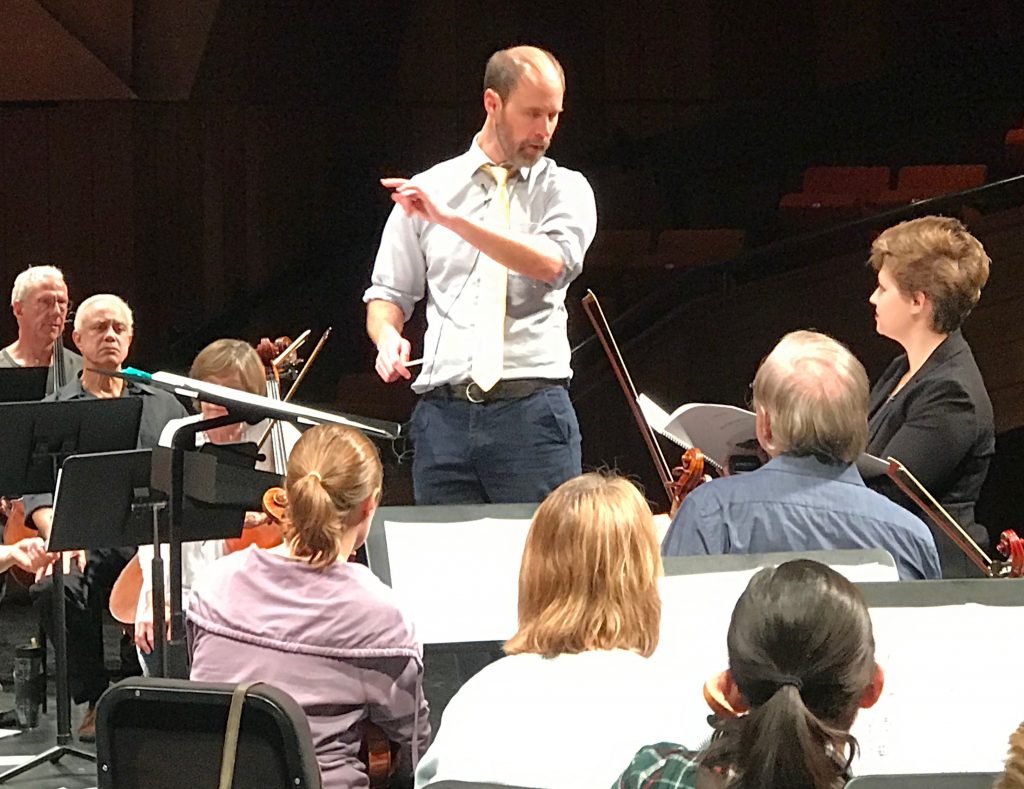
On Election Day, the Toledo Symphony Orchestra arrived on campus for the 8th annual Student Composer Reading Session.
Five student composers were selected to have their pieces rehearsed, played and recorded by the orchestra. This is a rare opportunity for young composers to have a professional orchestra play their music, and receive feedback on the scores.
On the program Tuesday were:
- Adam Har-zvi’s “The Bartlebooth Fantasy”, a piece inspired by a character from the novel “Life, A User’s Manual.”
- Nicholas E.M. Osborn’s “Gray Sealed Chamber,” that takes its theme from a poem about a pointless chase.
- Sam Longo-Capobianco’s “black box [1] about which the composer wrote — “To me, the musical mind is a black box: I put together a plan for a piece and over time music emerges.”
- Benjamin T. Nylaner’s “Portrait of a Dreamer,” in which the composer seeks to create the image “of vast atmospheres, separated in the middle by a ceaseless, boiling turmoil that inevitably spills over.”
- Indigo Knecht’s “free the black birds,” written in memory of teenager who died in 2017 after a long struggle with mental illness.
The composers did not go easy on the orchestra, filling the scores with odd meters and rhythms, and special effects. The musicians were undeterred. The orchestra had time to play all but one piece twice. After the initial run-through, the composer would get on stage to answer questions from the orchestra and make comments.
Michael Lewandowski, who conducted, told the orchestra that performing these sessions was an investment in the future of classical orchestra music.
“Shadows”
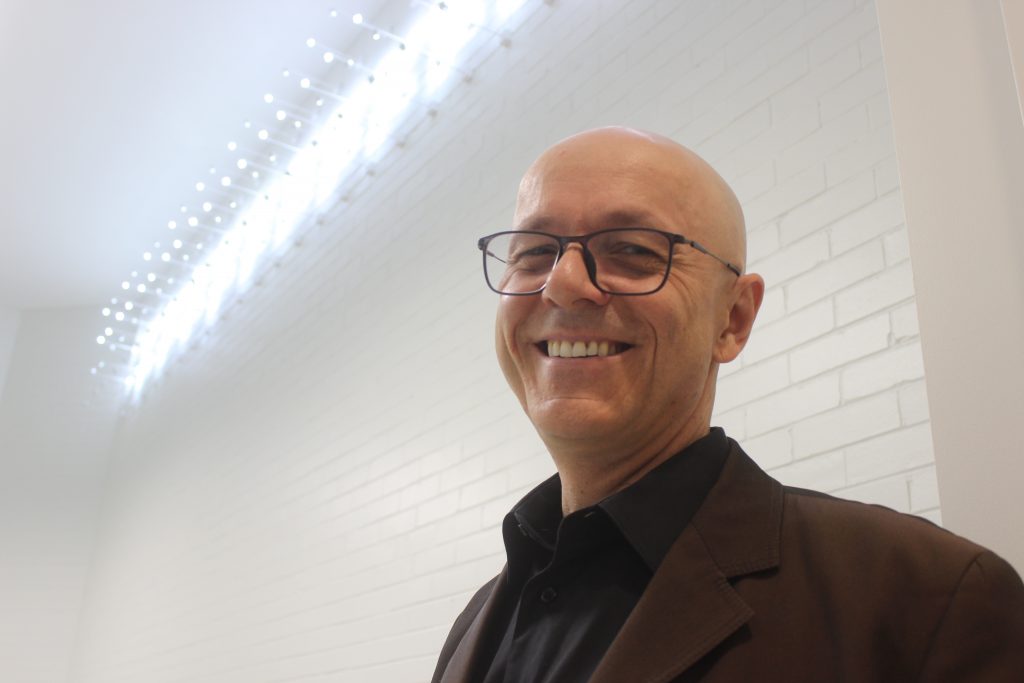
On Monday, the light sculpture “Shadows” was dedicated in the top of the staircase on the fourth floor of Moseley Hall.
The piece is the work of Erwin Redl, an Austrian-born international artist who now resides in Bowling Green and maintains a fabrication studio in an old factory on Napoleon Road.
Redl said he wanted to use “very simple elements, lights and objects, to create with shadow movement over time.”
With just LED lights and sticks, he creates wave patterns that move along the walls and contrast with the grid patterns of the brick wall. The intent is to create a contemplative atmosphere.
The changes, he said, can be almost imperceptible. The work includes 20 basic sequences that change randomly so even the artist doesn’t know what will come next.
The circuitry behind his work is what most fascinates him, Redl said in his remarks.
The sculpture was purchased through the Ohio Percent for Art program, which appropriates 1 percent of the cost of a project to buying art for it. The Moseley renovation cost about $21 million.
Redl has work around the world, and now there’s a piece in the place he calls home. He has done temporary installations for ArtsX.
“It’s like a homecoming,” said Charles Kanwischer, director of the School of Art. “Here’s this world renowned artist living in Bowling Green, but we didn’t have a piece of his. It didn’t make sense. Now we do.”
Kanwischer said that the university has been interested in working with Redl, but the fit was never there. His work had been considered for other projects.
“Shadows” was selected from a national field of candidates.
The work’s use of technology is fitting for a building devoted to the study of science, Kanwischer said.
Redl doesn’t have a formal connection to the university, but he hires graduates from the School of Art for his four-person Bowling Green crew.
Redl said he likes Bowling Green where he moved about 10 years ago because “it’s very quiet and I can focus. And I have very good people who work with me.” He also has a second team in New York City.
The cost of living and work space is very affordable, he added. That said, Redl added, “I’m here but I’m traveling all the time.”


